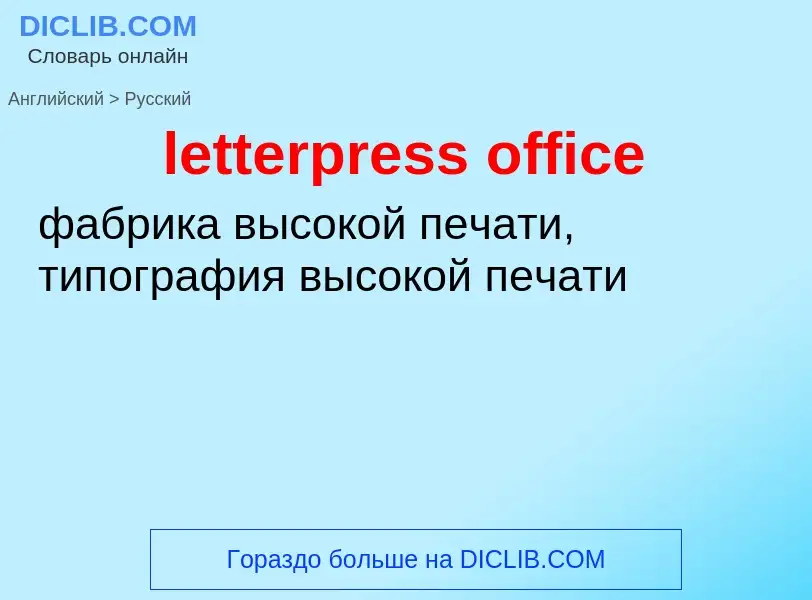Перевод и анализ слов искусственным интеллектом ChatGPT
На этой странице Вы можете получить подробный анализ слова или словосочетания, произведенный с помощью лучшей на сегодняшний день технологии искусственного интеллекта:
- как употребляется слово
- частота употребления
- используется оно чаще в устной или письменной речи
- варианты перевода слова
- примеры употребления (несколько фраз с переводом)
- этимология
letterpress office - перевод на русский
общая лексика
малый офис
под этим понятием подразумевается фирма численностью до 20 человек, имеющая единый офис
Смотрите также
Определение
Википедия

Letterpress printing is a technique of relief printing for producing many copies by repeated direct impression of an inked, raised surface against individual sheets of paper or a continuous roll of paper. A worker composes and locks movable type into the "bed" or "chase" of a press, inks it, and presses paper against it to transfer the ink from the type, which creates an impression on the paper.
In practice, letterpress also includes wood engravings, photo-etched zinc plates ("cuts"); linoleum blocks, which can be used alongside metal type; wood type in a single operation; stereotypes; and electrotypes of type and blocks. With certain letterpress units, it is also possible to join movable type with slugs cast using hot metal typesetting. In theory, anything that is "type high" and so forms a layer exactly 0.918 in. thick between the bed and the paper can be printed using letterpress.
Letterpress printing was the normal form of printing text from its invention by Johannes Gutenberg in the mid-15th century to the 19th century and remained in wide use for books and other uses until the second half of the 20th century. Letterpress printing remained the primary means of printing and distributing information until the 20th century, when offset printing was developed, which largely supplanted its role in printing books and newspapers. More recently, letterpress printing has seen a revival in an artisanal form.


![Preparation for the Virgil Scott Letterpress Exhibit at [[Texas A&M University–Commerce]] in January 2015 Preparation for the Virgil Scott Letterpress Exhibit at [[Texas A&M University–Commerce]] in January 2015](https://commons.wikimedia.org/wiki/Special:FilePath/15020-Virgil Scott Letterpress Exhibit 4540 (15782867404) (2).jpg?width=200)
.jpg?width=200)
![1917 press room, using a [[line shaft]] power system. At right are several small platen [[jobbing presses]], at left, a [[cylinder press]]. 1917 press room, using a [[line shaft]] power system. At right are several small platen [[jobbing presses]], at left, a [[cylinder press]].](https://commons.wikimedia.org/wiki/Special:FilePath/Fitzwilliam Press Room 1917.jpg?width=200)
![Tools for composing by hand: block of type tied up, a [[composing stick]], a bodkin, and string, all resting in a type galley. Tools for composing by hand: block of type tied up, a [[composing stick]], a bodkin, and string, all resting in a type galley.](https://commons.wikimedia.org/wiki/Special:FilePath/Handsatz Zubehoer.jpg?width=200)
![quoins]]" quoins]]"](https://commons.wikimedia.org/wiki/Special:FilePath/New Testament in chase.jpg?width=200)
![A modern letterpress workshop at the [[Basel Paper Mill]], Basel, Switzerland A modern letterpress workshop at the [[Basel Paper Mill]], Basel, Switzerland](https://commons.wikimedia.org/wiki/Special:FilePath/Papiermuseum Basel 2008 (28).jpg?width=200)





